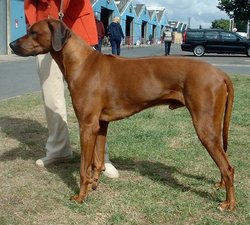
|
From Wikipedia the free encyclopedia, by MultiMedia |
| Rhodesian Ridgeback | |
|---|---|

The Rhodesian Ridgeback is the only breed besides the
Thai Ridgeback with a ridge of fur along the spine.
|
|
| Alternative names | |
| Country of origin | |
| southern Africa | |
| Common nicknames | |
| Classification and breed standards | |
| FCI: | Group 6 Section 3 #146 |
| AKC: | Hound |
| ANKC: | Group 4 (Hounds) |
| CKC: | Group 2 - Hounds |
| KC (UK): | Hound |
| NZKC: | Hounds |
| UKC: | {{{ukcgroup}}} |
| Not recognized by any major kennel club | |
| This breed of Dog is extinct | |
| Notes | |
The Rhodesian Ridgeback is a breed of Dog from Rhodesia (now Zimbabwe and Zambia) in Southern Africa. Also known as the "(African) Lion Dog" because of their unique ability to taunt a lion and keep it at bay while awaiting their master to make the kill. They rarely bark while hunting.
The Ridgeback's general appearance is of a handsome, strong, muscular and active Dog, symmetrical in outline, capable of great endurance with a fair (good) amount of speed. The mature Dog is handsome and upstanding. The Ridgeback's distinguishing feature is the ridge of hair along its back running in the opposite direction to the rest of its coat. The ridge must be regarded as the escutcheon of the breed. It consists of a fan-like area formed by two whorls of hair (called "crowns") and tapers from immediately behind the shoulders, down to the level of the hips. The ridge is derived from the ridged hunting Dog of the Khoikhoi (literally, "men of men"; native South African people, referred to by the Europeans as Hottentots).
Some Ridgebacks are born without ridges, and until recently, most ridgeless puppies were culled, or euthanized, at birth. Today, many breeders opt instead to spay and neuter these offspring to ensure they will not be bred.
Male Ridgebacks should be 25-27 inches (63-69 cm) at the withers and weigh approximately 85 lb (36.5 kg FCI Standard), females 24-26 inches (61-66 cm) and approximately 70 lb (32 kg). They are typically muscular and have a light wheaten to red wheaten coat which should be short and dense, sleek and glossy in appearance but neither woolly nor silky. The presence of black guard hairs or ticking is not addressed in the AKC standard, although the elaboration of the AKC standard [1] notes the amount of black or dark brown in the coat should not be excessive. White is acceptable on the chest and toes.
Ridgebacks have a strong, smooth tail, which is usually carried in a gentle curve upwards. The eyes should be round and should reflect the coat coloródark in a black muzzle, amber with a brown nose. The brown nose is a recessive gene and is therefore not as common as a black nose.
The original standard allowed for a variety of coat colors, including brindle and sable. Today, all shades of wheaten are permitted. While the deeper red are often favored by pet owners, the lighter wheaten is just as correct. Color variants such as brindles, black-and-tans and blue dilutes appear occasionally but not commonly.
They are loyal, intelligent, and gentle, making them good family pets despite their size. They were traditionally hunters, guardians, and companions.
The breed's long history dates back to early in the 18th century when the first European settlers found with the Khoisan tribes a domesticated Dog with the hair on his spine being turned forward. To fill their specific needs for a serviceable hunting Dog in the wilds, these settlers developed, by selective breeding between Dogs which they had brought with them from home countries and the half-wild ridged Dog of the Hottentot tribes, a distinct breed of the African veldt, which has come to be known as the Rhodesian Ridgeback.
The Breed Standard is based on that of the Dalmation & was first registered in South Africa in 1924. The breed was first admitted into the American Kennel Club in 1955 as a member of the Hound Group.
As hunters, Ridgebacks kept a lion at bay while the hunters came to kill it. The Dogs worked in groups to keep the lion occupied until the hunter arrived; the Dogs themselves did not actually kill lions.
Health conditions known to affect this breed are cataracts, cancer, and hip dysplasia. Average lifespan is from 9-11 years but they have been know to live to nearly 16 years but this is very rare.
Dermoid sinus is a congenital condition that is known to affect this breed.
There is some debate whether the Rhodesian Ridgeback is a sighthound or scent hound. In general, Ridgebacks pursue prey by sight, but after the prey is no longer in sight, Ridgebacks continue tracking with scent. More credibility is given to the sight argument largely because the Ridgeback seldom barks, a technique scent hounds more often use to allow both hunters and hounds to follow.